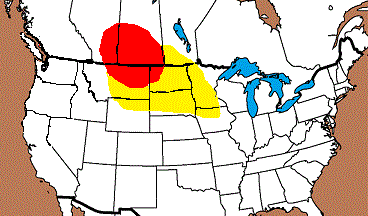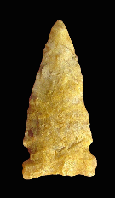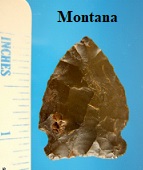Outline is Representative of Size and Shape:

Name Details:
Identified By: Thomas Kehoe /
Bruce McCorquodale
Named For: Type Site
Date Identified: 1961
Type Site: Avonlea Site, south central Saskatchewan, Canada / Gull Lake Bison Kill Site Saskatchewan, Canada
Identified By: Thomas Kehoe /
Bruce McCorquodale
Named For: Type Site
Date Identified: 1961
Type Site: Avonlea Site, south central Saskatchewan, Canada / Gull Lake Bison Kill Site Saskatchewan, Canada
Point Validity:
Valid type
Kehoe is a professional Anthropologist who worked extensively on archeology of Montana and served as both a professor and curator at the Museum of the Plains Indian at Browning Montana. McCorquodale is a respected Anthropologist and did extensive work on the plains and Canadian archeology. This type was named in a professional publication and has many professional references. This is considered a valid type.
Kehoe is a professional Anthropologist who worked extensively on archeology of Montana and served as both a professor and curator at the Museum of the Plains Indian at Browning Montana. McCorquodale is a respected Anthropologist and did extensive work on the plains and Canadian archeology. This type was named in a professional publication and has many professional references. This is considered a valid type.
Timber Ridge Side Notch
AKA: Avonlea Timber Ridge Side Notch "Sharp Eared Variant"
Cluster: Plains Small Side Notch Cluster
Description of Physical Characteristics and Flaking Pattern:
This is a thin small to medium point with an elliptical to flattened cross section. The blade may range from straight to excurvate. The shoulders may vary from horizontal to having an upward angle. The stem may be expanding or expanded. The base may vary from concaved to bifurcated. The basal ears are generally sharper for this variant than for other variations. This point exhibits refined pressure flaking forming a random flaking pattern.
Size Measurements:
Total Length - 12 to 42 mm, Blade Width - 9 to 18 mm, Thickness - 2 to 4 mm
Total Length - 12 to 42 mm, Blade Width - 9 to 18 mm, Thickness - 2 to 4 mm
Commonly Utilized Material:
Various locally available materials. Harder to work with materials are commonly heat treated including Avon Chert and Knife River Flint
Various locally available materials. Harder to work with materials are commonly heat treated including Avon Chert and Knife River Flint
Additional Comments:
This type is thought to have evolved from the Pelican Lake type. Avonlea points are the earliest of the Prairie Side Notch type. This type evolved into the Swift Current type which became the Prairie Side Notch (Kehoe (1966).
As described (illustrated) by Kehoe (1966)
This type is thought to have evolved from the Pelican Lake type. Avonlea points are the earliest of the Prairie Side Notch type. This type evolved into the Swift Current type which became the Prairie Side Notch (Kehoe (1966).
As described (illustrated) by Kehoe (1966)

Distribution:
Distribution Comments:
This point is primarily found in Saskatchewan and Alberta Canada and into Montana (red). They are found with less frequency into northern Wyoming, northern South Dakota, northwestern Iowa, and western Minnesota (yellow).
This point is primarily found in Saskatchewan and Alberta Canada and into Montana (red). They are found with less frequency into northern Wyoming, northern South Dakota, northwestern Iowa, and western Minnesota (yellow).
Age / Periods:
Date: 1,800 - 900 B.P.
Cultural Period: Late Woodland /
Developmental
Glacial Period: Roman to Medieval Warm
Culture: Avonlea Culture
Date: 1,800 - 900 B.P.
Cultural Period: Late Woodland /
Developmental
Glacial Period: Roman to Medieval Warm
Culture: Avonlea Culture
Age Details:
Morrow (2016) notes "Avonlea points are considered a horizon marker for the early Late Prehistoric period in the Canadian Plains. It dates from 100 to 1100 C.E. on the Northern Plains (Gregg and Davidson 1985:128; Johnson 1998:38). These points are thought by some to be the earliest evidence for the bow and arrow on the Plains."
Morrow (2016) notes "Avonlea points are considered a horizon marker for the early Late Prehistoric period in the Canadian Plains. It dates from 100 to 1100 C.E. on the Northern Plains (Gregg and Davidson 1985:128; Johnson 1998:38). These points are thought by some to be the earliest evidence for the bow and arrow on the Plains."
Similar Points:
Besant,Bratton, Elko Eared, Irvine, Nanton, Pekisko, Samantha, Swift Current, Tompkins, Washita
Besant,Bratton, Elko Eared, Irvine, Nanton, Pekisko, Samantha, Swift Current, Tompkins, Washita
Other points in this cluster / Related / Associated Points:
Avonlea Carmichael,, Avonlea Timber Ridge, Plains Side Notch, Prairie Side Notch, Swift Current
Avonlea Carmichael,, Avonlea Timber Ridge, Plains Side Notch, Prairie Side Notch, Swift Current



